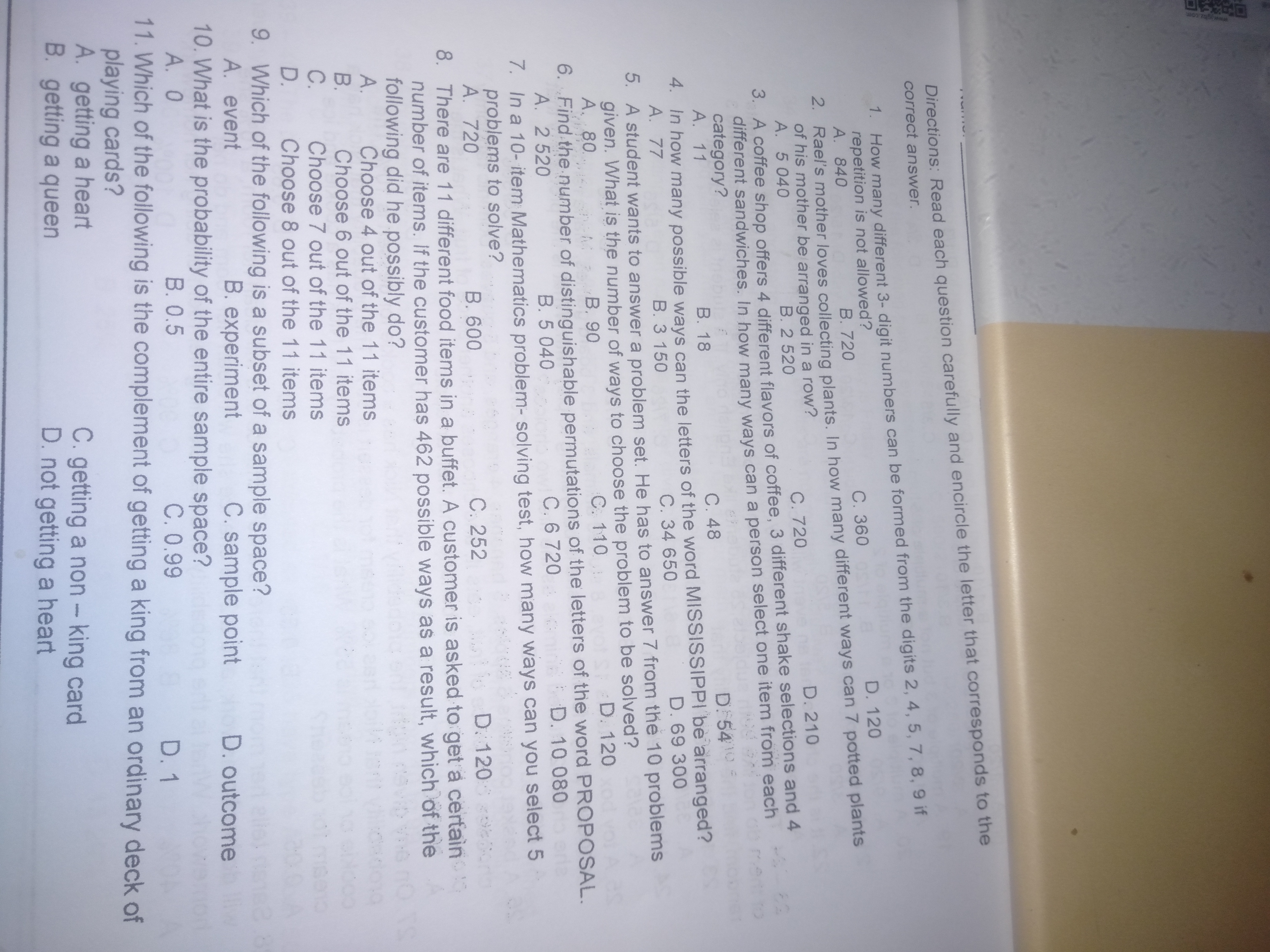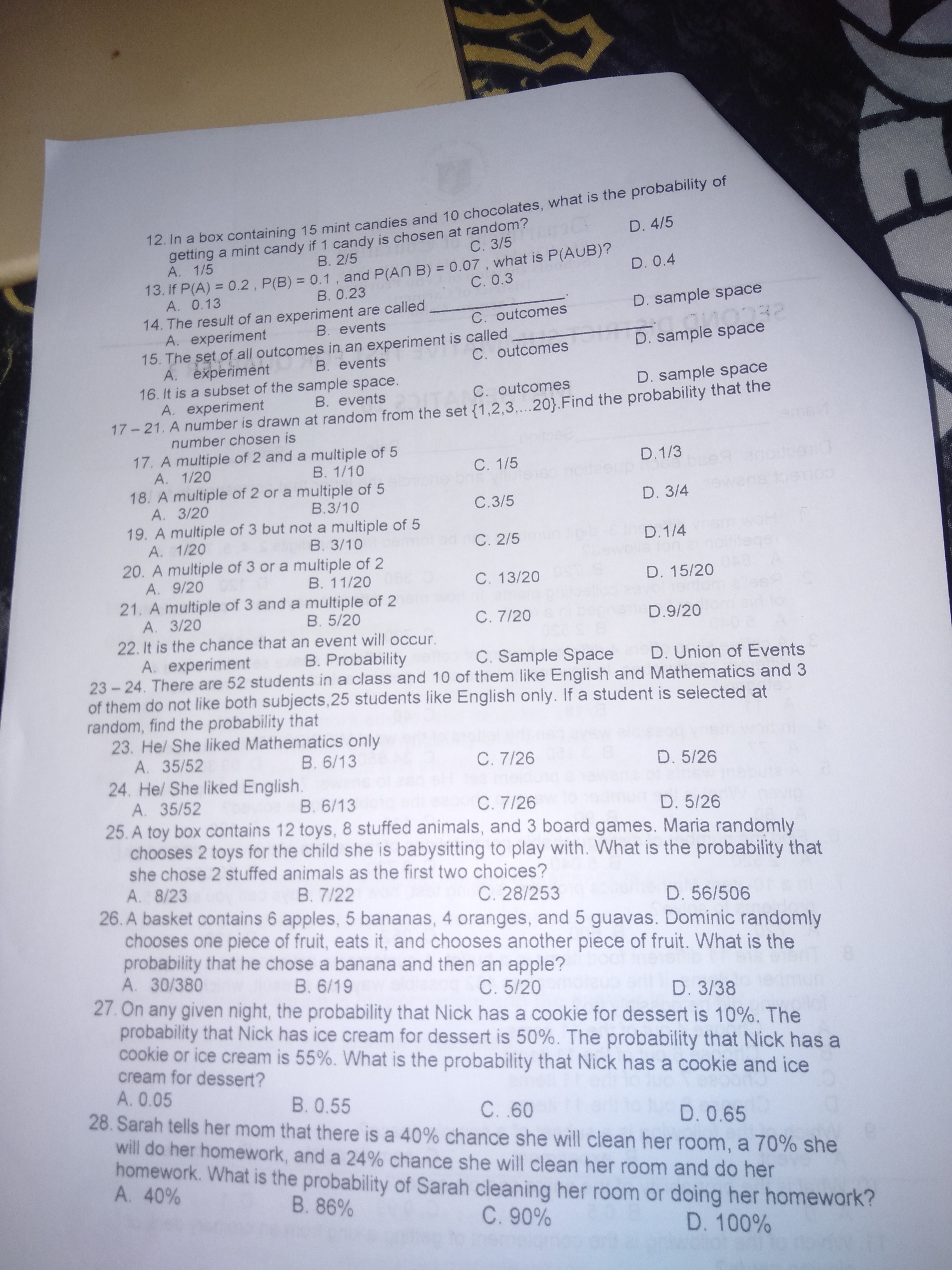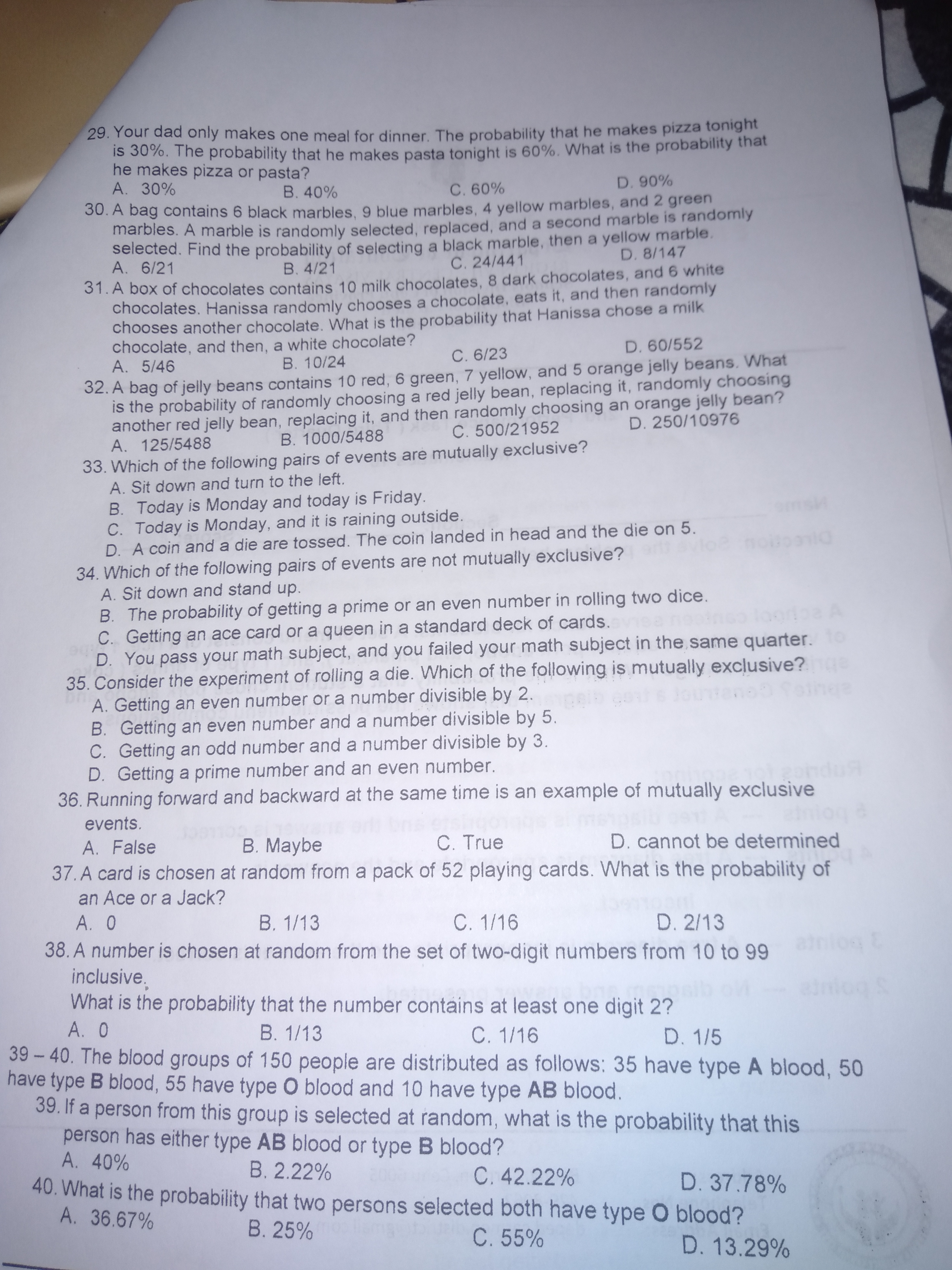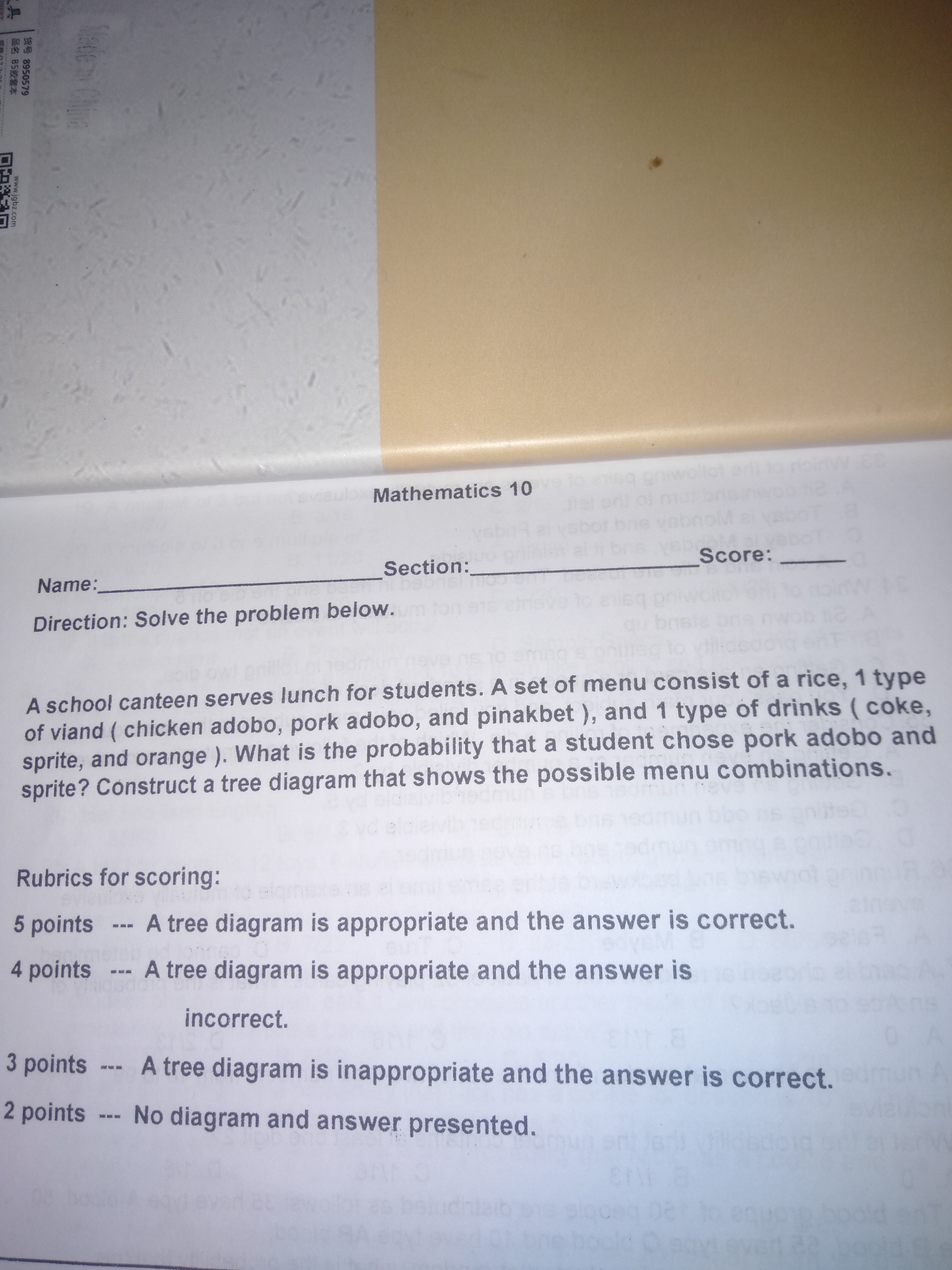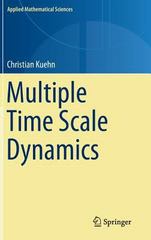HELP ME PLEASE..
Directions: Read each question carefully and encircle the letter that corresponds to the correct answer. 1. How many different 3- digit numbers can be formed from the digits 2, 4, 5, 7, 8, 9 if repetition is not allowed? C. 360 D. 120 A. 840 B. 720 2. Rael's mother loves collecting plants. In how many different ways can 7 potted plants of his mother be arranged in a row? D. 210 A. 5 040 B. 2 520 C. 720 3. A coffee shop offers 4 different flavors of coffee, 3 different shake selections and 4 different sandwiches. In how many ways can a person select one item from each category? D 5410 A. 11 B. 18 C. 48 4. In how many possible ways can the letters of the word MISSISSIPPI be arranged? A. 77 B. 3 150 C. 34 650 D. 69 300 5. A student wants to answer a problem set. He has to answer 7 from the 10 problems given. What is the number of ways to choose the problem to be solved? A. 80. B. 90 C. 110 :D: 120 6. Find the number of distinguishable permutations of the letters of the word PROPOSAL. A. 2 520 B. 5 040 C. 6 720 D. 10 080 7. In a 10- item Mathematics problem- solving test, how many ways can you select 5 problems to solve? A. 720 B. 600 C. 252 8. There are 11 different food items in a buffet. A customer is asked to get a certain number of items. If the customer has 462 possible ways as a result, which of the following did he possibly do? A. Choose 4 out of the 11 items B. Choose 6 out of the 11 items C . Choose 7 out of the 11 items D. Choose 8 out of the 11 items 9. Which of the following is a subset of a sample space? A. event B. experiment C. sample point D. outcome 10. What is the probability of the entire sample space? A. 0 B. 0.5 C. 0.99 D. 1 11. Which of the following is the complement of getting a king from an ordinary deck of playing cards? A. getting a heart C. getting a non - king card B. getting a queen D. not getting a heart12. In a box containing 15 mint candies and 10 chocolates, what is the probability of getting a mint candy if 1 candy is chosen at random? D. 4/5 C. 3/5 A. 1/5 B. 2/5 13. If P(A) = 0.2 , P(B) = 0.1, and P(An B) = 0.07 , what is P(AUB)? D. 0.4 C. 0.3 A. 0.13 B. 0.23 14. The result of an experiment are called D. sample space C. outcomes A. experiment B. events 15. The set of all outcomes in an experiment is called D. sample space C. outcomes A. experiment B. events 16. It is a subset of the sample space D. sample space B. events C. outcomes A. experiment 17 - 21. A number is drawn at random from the set {1,2,3,...20}. Find the probability that the number chosen is 17. A multiple of 2 and a multiple of 5 B. 1/10 C. 1/5 D. 1/3 A. 1/20 18. A multiple of 2 or a multiple of 5 A. 3/20 B.3/10 C.3/5 D. 3/4 19. A multiple of 3 but not a multiple of 5 A. 1/20 B. 3/10 C. 2/5 D. 1/4 20. A multiple of 3 or a multiple of 2 A. 9/20 B. 11/20 C. 13/20 D. 15/20 21. A multiple of 3 and a multiple of 2 A. 3/20 B. 5/20 C. 7/20 D.9/20 22. It is the chance that an event will occur. A. experiment B. Probability C. Sample Space D. Union of Events 23 - 24. There are 52 students in a class and 10 of them like English and Mathematics and 3 of them do not like both subjects, 25 students like English only. If a student is selected at random, find the probability that 23. He/ She liked Mathematics only A. 35/52 B. 6/13 C. 7/26 D. 5/26 24. He/ She liked English A. 35/52 B. 6/13 C. 7/26 D. 5/26 25. A toy box contains 12 toys, 8 stuffed animals, and 3 board games. Maria randomly chooses 2 toys for the child she is babysitting to play with. What is the probability that she chose 2 stuffed animals as the first two choices? A. 8/23 B. 7/22 C. 28/253 D. 56/506 26. A basket contains 6 apples, 5 bananas, 4 oranges, and 5 guavas. Dominic randomly chooses one piece of fruit, eats it, and chooses another piece of fruit. What is the probability that he chose a banana and then an apple? A. 30/380 B. 6/19 C. 5/20 D. 3/38 27. On any given night, the probability that Nick has a cookie for dessert is 10%. The probability that Nick has ice cream for dessert is 50%. The probability that Nick has a cookie or ice cream is 55%. What is the probability that Nick has a cookie and ice cream for dessert? A. 0.05 B. 0.55 C. .60 28. Sarah tells her mom that there is a 40% chance she will clean her room, a 70% she D. 0.65 will do her homework, and a 24% chance she will clean her room and do her A. 40% B. 86% homework. What is the probability of Sarah cleaning her room or doing her homework? C. 90% D. 100%29. Your dad only makes one meal for dinner. The probability that he makes pizza tonight is 30%. The probability that he makes pasta tonight is 60%. What is the probability that he makes pizza or pasta? A. 30% B. 40% C. 60% D. 90% 30. A bag contains 6 black marbles, 9 blue marbles, 4 yellow marbles, and 2 green marbles. A marble is randomly selected, replaced, and a second marble is randomly selected. Find the probability of selecting a black marble, then a yellow marble. A. 6/21 B. 4/21 C. 24/441 D. 8/147 31. A box of chocolates contains 10 milk chocolates, 8 dark chocolates, and 6 white chocolates. Hanissa randomly chooses a chocolate, eats it, and then randomly chooses another chocolate. What is the probability that Hanissa chose a milk chocolate, and then, a white chocolate? D. 60/552 A. 5/46 B. 10/24 C. 6/23 32. A bag of jelly beans contains 10 red, 6 green, 7 yellow, and 5 orange jelly beans. What is the probability of randomly choosing a red jelly bean, replacing it, randomly choosing another red jelly bean, replacing it, and then randomly choosing an orange jelly bean? A. 125/5488 B. 1000/5488 C. 500/21952 D. 250/10976 33. Which of the following pairs of events are mutually exclusive? A. Sit down and turn to the left. B. Today is Monday and today is Friday. C. Today is Monday, and it is raining outside. D. A coin and a die are tossed. The coin landed in head and the die on 5. 34. Which of the following pairs of events are not mutually exclusive? A. Sit down and stand up. B. The probability of getting a prime or an even number in rolling two dice. C. Getting an ace card or a queen in a standard deck of cards. D. You pass your math subject, and you failed your math subject in the same quarter. 35. Consider the experiment of rolling a die. Which of the following is mutually exclusive? A. Getting an even number or a number divisible by 2. B. Getting an even number and a number divisible by 5 C. Getting an odd number and a number divisible by 3. D. Getting a prime number and an even number. 36. Running forward and backward at the same time is an example of mutually exclusive events. A. False B. Maybe C. True D. cannot be determined 37. A card is chosen at random from a pack of 52 playing cards. What is the probability of an Ace or a Jack? A. 0 B. 1/13 C. 1/16 D. 2/13 38. A number is chosen at random from the set of two-digit numbers from 10 to 99 atlos E inclusive. What is the probability that the number contains at least one digit 2? A. 0 B. 1/13 C. 1/16 D. 1/5 39 - 40. The blood groups of 150 people are distributed as follows: 35 have type A blood, 50 have type B blood, 55 have type O blood and 10 have type AB blood 39. If a person from this group is selected at random, what is the probability that this person has either type AB blood or type B blood? A. 40% B. 2.22% C. 42.22% D. 37.78% A. 36.67% 40. What is the probability that two persons selected both have type O blood? B. 25% C. 55% D. 13.29%1 8950579 Mathematics 10 Name: Section: Score: Direction: Solve the problem below. A school canteen serves lunch for students. A set of menu consist of a rice, 1 type of viand ( chicken adobo, pork adobo, and pinakbet ), and 1 type of drinks ( coke, sprite, and orange ). What is the probability that a student chose pork adobo and sprite? Construct a tree diagram that shows the possible menu combinations. Rubrics for scoring: 5 points --- A tree diagram is appropriate and the answer is correct. 4 points --- A tree diagram is appropriate and the answer is incorrect. 3 points --- A tree diagram is inappropriate and the answer is correct. 2 points --- No diagram and answer presented
